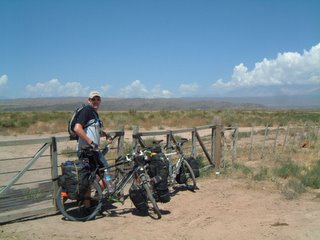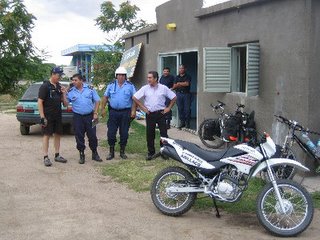 This is one of tens of thousands of old Ford Falcons still rollin the roads down here......this is in better shape than most...seen a few that appear to be held together by only by duct tape.
This is one of tens of thousands of old Ford Falcons still rollin the roads down here......this is in better shape than most...seen a few that appear to be held together by only by duct tape.
Well, the weather was looking grim in Catamarca and we were told that it would get more rainy and more tropical if we headed north towards Bolivia (they grow sugar cane north of here) so we tore down the bikes and bussed it back to Mendoza (Sun Central - think a hotter Osoyoos in the summer). So it was 9 hours jammed in a hot bus retracing much of our route north, listening to all my MP3 music twice, all of my BBC podcasts, finishing my book, starting a new book, and sleeping, we finally arrived in Mendoza at 10 pm. Nice to be back to home base but what a change from before New Year when we were here last ... the city was packed with tourists, mostly Argentines from BA. Took 2 hrs just to find a place to stay. But never fear missing a meal the restaurants, which don't open until 9pm, don't close until 1am weekdays and 2am weekends - more on their crazy eating habits later.
Next day back on the bikes, see we read that the mountain roads west of Mendoza were spectacular so we set off for the montain town of Uspallata (oos pah ja ta) and then north into the Caligata Valley in the province of San Juan.


First day was pretty casual as we traveled south of town to Lujuan de Cuyo to meet up with the roads heading west. It was easy pedalling anlong flat roads through sunny vinyards, garlic fields, stopping at fruit stands (and trucks), and admireing the snow capped andes in the distance.



Day 2 was the exact opposite; a greuling climb into a narrow valley, along an equally narrow road, along a rushing chocolate brown river. The road leads 200 kms up the valley towards Acanguaga the America´s highest mountain at 21,000ft and then into Chile but we turn off short of the border and are to head north. The hills along this road were the steepest encountered so far on the trip and as the day progressed, the truck and bus traffic increased making it pretty dicey at some narrow sections with 18 wheelers on one side, a 12" wide shoulder to ride on, and steep drop offs to the river on the other side. Fortunately there is a phenominon here called the Siesta that mysteriuosly happens between the hours of 1pm and 6 pm every day - the whole country gets kinda sleepy, stores and offices close down, policia disapear, and best of all most trucks pull over for a nap. It was a nice break from the traffic but as skys darkened above in early afternoon more excitement - this time bolts of lightning. I´m thinking that way down in this valley we are not likely targets but you sure get second thoughts as bolts crack into the hills directly above you ringing your ears. Look ahead, more adventure, 4 consecutive tunnels, and then more in the distance. Good places to hide from the lightning, but room only enough for 2 passing vehicles. A biker meeting passing vehicles in one of these tunnels would be in big trouble. We dug out or halogen head lamps, listened for vehicle noice, peered as far up and down the road as possible for vehicles as we could and picked just the right time to make it through....or at least you think you called it right untill inside the dark tunnel, heart beating, pedaling as fast as you can you wonder if you can hear vehicles comeing from behind.........whew made it through but what about the next 5 ahead. Well, we must have called it right each time but don't need that kind of excitement any more. 100kms later and a cruel final 10 kms uphill into the wind we made it to Uspallata to see the sun setting behind the Andes and man did that first beer taste good. 
Day 3.....Well as you can see by this photo of Al's back wheel, legs were not the only thing suffering from fatigue. This spoke on Al's rear wheel pulled out along with a good sized chunck of the wheel metal...now it makes a whistle like my first old junker car when rolling down the hill - easy to hear Al racing up behind me.
back wheel, legs were not the only thing suffering from fatigue. This spoke on Al's rear wheel pulled out along with a good sized chunck of the wheel metal...now it makes a whistle like my first old junker car when rolling down the hill - easy to hear Al racing up behind me.
We found a bike shop in Uspallata but the bike mechanic did not have any parts and just said "no problema" and cut off the old spoke. Told us to carry on as he did not think the wheel would colapse. Well contrary to our better judgements we continued on the next day over a 2200 meter (7000ft) dirt road pass. Turns out the wheel did OK and was the least of our worries. After 4 hours of climbing at early afternoon we had only covered about 25 kms (75 to go) and the previoulsy blue skys started to darken - no more towering mountain peaks only dark skies then lightning bolts, closer and closer. We were near the top of the pass, no protection, nowhere to hide and cracks of lightning everywhere. No need to count the seconds between the light and the sound they were dam close. Felt like were were under sniper fire without any cover. Then I'm thinking basic electricity...here I am with metal cleated bike shoes connected to my metal bike, tallest objects in the area. So we jumped off our bikes, changed shoes to runners, found a shallow ditch, and sat crouched on the balls of our feet for 45 minutes trying to minimize earth contact waiting to either get hit or survive. Well after that it was all easy - made it to the top and hour later skirted a few more storms, and ended up camping on this dry lake bed on the north side of the pass. Couldn't help riding around the perfectly smooth flat dirt lake a few times before setting up our tents. Heard later from locals that people sail on the lake with wheeled carts and high tech wheeled "yachts". Above the dry lake bed were 3 or 4 observatories high on the overlooking hills....saw why they were there when the sun went down as the night sky was unbelievable.

The next morning a few more bike repairs (Al's front rack collapsed - carrying too much water, and I had yet another flat from thorns) and we were on our way across the dry lake to the little town of Barreal.






















































